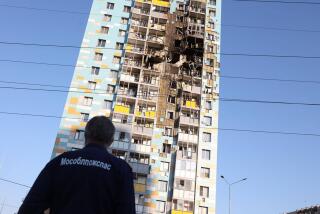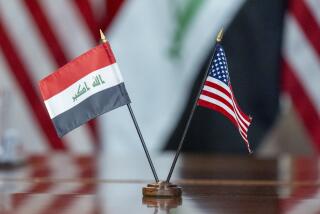U.S. Jets Return Fire After Being Shot At by Iraqis
WASHINGTON — Four U.S. warplanes were shot at by Iraqi artillery in the northern no-fly zone in Iraq and returned the fire with cluster bombs on Friday, the U.S. government said. It was the first hostile exchange in more than two months.
The planes were not hit and returned to Incirlik Air Base in Turkey, said State Department spokesman Richard A. Boucher. Iraq said a soldier guarding a dam was wounded by the U.S. bombing.
Boucher said the planes were on a routine monitoring mission in the zone set up to protect Kurds from Iraqi attack.
The fighter planes--three F-16s and an F-4G--dropped four cluster bombs on the artillery battery after being fired on, a Pentagon statement said. It wasn’t clear whether the U.S. planes hit the artillery emplacement, the statement added.
The anti-aircraft battery fired on the U.S. jets at 1:05 p.m. Iraqi time--3:05 a.m. PDT--north of the 36th Parallel, the Pentagon said.
Iraqi radar was tracking the planes before they were fired on, according to the U.S. European Command in Stuttgart, Germany.
“When threatened, U.S. forces will respond as they did,” said White House press secretary Dee Dee Myers. “We remain determined to enforce all relevant U.N. resolutions.” She said President Clinton had been notified of the situation; he was in Little Rock, Ark., attending a memorial service for his father-in-law.
At the State Department, Boucher said the United States and its coalition partners remain determined to enforce the no-fly zone.
“The latest incident underscores Iraq’s continued failure to abide by these resolutions and its international obligations,” he said.
The last hostilities in Iraq occurred on Feb. 3, when two French F-1 Mirage reconnaissance aircraft were fired upon.
Friday’s incident was the first time that U.S. planes have been fired on since Clinton’s inauguration on Jan. 20, although two U.S. jets attacked a northern missile site on Jan. 21 after Iraqi radar tracked them.
An Administration official, speaking on condition of anonymity, said the U.S. warplanes were flying at about 8,000 feet--above the range of the antiaircraft artillery.
The northern no-fly zone--north of the 36th Parallel--was imposed by the U.S.-led allies in April, 1991, to protect Kurdish rebels from Iraqi attacks. The southern zone, south of the 32nd Parallel, was declared last August to protect rebellious Shiite Muslims.
American, British and French warplanes patrol the two no-fly zones.
On Jan. 20, Iraqi President Saddam Hussein declared a unilateral cease-fire to give the new American President a chance to review U.S. policy toward Iraq.
It followed numerous exchanges in the final weeks of the George Bush Administration, including a series of U.S.-led attacks against Iraqi defensive positions and an industrial plant near Baghdad.
Clinton vowed to follow the same hard-line policy as his predecessor to force Iraq to comply with all U.N. resolutions, but there have been few provocative actions by Iraq since he took office.
The state-run Iraqi News Agency quoted a Foreign Ministry spokesman as saying the nation dropping the bombs would “bear responsibility for this aggressive and provocative behavior.”
The spokesman said the Iraqi soldier was wounded while on guard duty in the northern Nineveh province.
The agency, monitored in Cyprus, quoted provincial Gov. Abdul-Jawad Dallul as saying U.S. aircraft attacked a military position “at lunchtime, when the air defense system were not in a state of preparedness.”
But he did not specifically deny opening fire on the planes. Dallul said the attack targeted the Saddam Dam tourist area “and a military position when the soldiers were having lunch. . . .”
At the State Department, Boucher said, “I want to state that the United States and our coalition partners remain determined to enforce all relevant United Nations Security Council resolutions and the various measures that were enacted to enforce them, including the two no-fly zones.
“Iraq understands clearly what its obligations are in regard to the no-fly zone and will be held solely responsible for the serious consequences of failure to comply with these obligations.”
Boucher said the four U.S. Air Force jets were assigned to Provide Comfort, the name of the operation enforcing the ban against Iraqi military flight in the prohibited areas. He said that once the planes were shot at, the three F16s dropped the cluster bombs.
The artillery battery was about two miles east of Saddam Dam, Boucher said.
More to Read
Sign up for Essential California
The most important California stories and recommendations in your inbox every morning.
You may occasionally receive promotional content from the Los Angeles Times.










